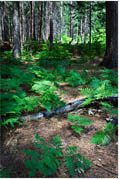 Log home owners often have a different set of challenges when it comes to landscaping around their newly constructed homes. We find that more often than not the building site is carved out of a wooded area with a mix of soft and hard woods. If you were able to keep a few of the existing mature trees in the cleared area around your new home that will give you a head start of creating an established looking landscape at the beginning. Homeowners who are clearing a section of forested land for their homes should consider walking the land with the forester and mark trees that will not be cut.
Log home owners often have a different set of challenges when it comes to landscaping around their newly constructed homes. We find that more often than not the building site is carved out of a wooded area with a mix of soft and hard woods. If you were able to keep a few of the existing mature trees in the cleared area around your new home that will give you a head start of creating an established looking landscape at the beginning. Homeowners who are clearing a section of forested land for their homes should consider walking the land with the forester and mark trees that will not be cut.
When the construction process is underway and you have some heavy equipment on-site, like an excavator, it’s well worth an extra half-day of excavation work to pull up the stumps from harvested trees and flip them over in the resulting hole, then cover with soil. This can speed the decomposition of the stumps and clear the way for grading and establishing flowerbeds and lawns.
 Know your soil
Know your soil
While the house is being constructed, there’s plenty of preparation work that can be done for your landscaping. Testing the soil around your new log home has many benefits. You’ll save time and energy in determining the appropriate treatment to bring soil up to growing consistency for your garden and lawn areas. You’ll also treat the environment around your home better if you can limit the amount of fertilizers you add. One natural way to "sweeten" the acid soil found in wooded areas is to spread lime in the spring or late fall.
Take some soil samples into your local farm extension or send samples to a soils laboratory to have them tested for acidity, alkalinity, and composition. Once you have this information you’ll be able to make educated decisions about what soil amendments you might need to add, whether additional topsoil will be needed and what soil preparation you’ll need to do to support flowers, shrubs and vegetables.
See what nature has to offer
Take a walk around the edges of your property line to see what kinds of plants are growing there. Take note of any wet areas or seasonal streams or ponds, and what plants are flourishing there. Many of the elements of your shade garden can be gathered and transplanted from the wooded portion of your land to provide color and interest along the edges of the woods. Some naturally occurring plants might include forest ferns, lady slippers, rhododendron, columbine, may apple or mayflower. In northern regions, look in wet areas for the American winterberry a member of the holly family, whose red berries attract birds and can be cut for holiday arrangements. 
Local knowledge is key
Make an appointment with an expert at the local lawn and garden center. If you avoid the hectic weekends at the garden center, you’ll get your questions answered in a less stressful environment. The garden center expert can help you identify flowers, vegetables and trees and shrubs that will suit your new home site.
Start small
You’ll be enjoying many years in your new home, so you may want to get accustomed to your surroundings before developing a large garden area. If you start small, and with a good variety of plants, you’ll be able to see what thrives and what doesn’t. Sketch out your garden plan on some paper, making sure taller growing plants won’t block out smaller plants. Vary the locations of plants depending on the blooming or maturity schedules, so that you have a pleasing palette through out the growing season.
Perennial Swap
One easy way to build your garden is to ask your gardening friends to a perennial swap meet. Each spring, perennial gardeners need to cut back and divide their established perennials. Much of the perennials have nowhere to go, so they end up on the compost pile. But gardeners can spend an enjoyable few hours sharing extra plants and new varieties of perennials that will give your own new garden a jumpstart at little cost.
